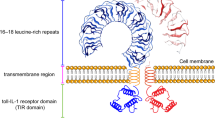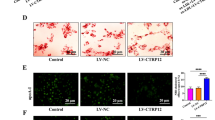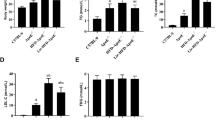Abstract
Aim:
Toll-like receptor 2 (TLR2) signaling plays a critical role in the initiation of atherosclerosis. The aim of this study was to investigate whether blocking TLR2 activity could produce therapeutic effects on advanced atherosclerosis.
Methods:
Forty-week old apolipoprotein E-deficient (ApoE−/−) mice fed on a normal diet were intravenously injected with a TLR2-neutralizing antibody or with an isotype-matched IgG for 18 weeks. Double-knockout ApoE−/−Tlr2−/− mice were taken as a positive control. At the end of the treatments, the plasma lipid levels were measured, and the plaque morphology, pro-inflammatory cytokines expression and apoptosis in arteries were analyzed. In the second part of this study, 6-week old ApoE−/− and ApoE−/−Tlr2−/− mice fed on a high-cholesterol diet for 12 to 24 weeks, the expression levels of TLR2 and apoptotic markers in arteries were examined.
Results:
Blockade of TLR2 activity with TLR2-neutralizing antibody or knockout of Tlr2 gene did not alter the plasma lipid levels in ApoE−/− mice. However, the pharmacologic and genetic manipulations significantly reduced the plaque size and vessel stenosis, and increased plaque stability in the brachiocephalic arteries. The protective effects of TLR2 antagonism were associated with the suppressed expression of pro-inflammatory cytokines IL-6 and TNF-α and the inactivation of transcription factors NF-κB and Stat3. In addition, blocking TLR2 activity attenuated ER stress-induced macrophage apoptosis in the brachiocephalic arteries, which could promote the resolution of necrotic cores in advanced atherosclerosis. Moreover, high-cholesterol diet more prominently accelerated atherosclerotic formation and increased the expression of pro-apoptotic protein CHOP and apoptosis in ApoE−/− mice than in ApoE−/−Tlr2−/− mice.
Conclusion:
The pharmacologic or genetic blockade of TLR2 activity diminishes and stabilizes advanced atherosclerotic lesions in ApoE−/− mice. Thus, targeting TLR2 signaling may be a promising therapeutic strategy against advanced atherosclerosis.
Similar content being viewed by others
Log in or create a free account to read this content
Gain free access to this article, as well as selected content from this journal and more on nature.com
or
References
Lopez AD, Mathers CD, Ezzati M, Jamison DT, Murray CJ . Global and regional burden of disease and risk factors, 2001: systematic analysis of population health data. Lancet 2006; 367: 1747–57.
Hansson GK, Robertson AK, Söderberg-Nauclér C . Inflammation and atherosclerosis. Ann Rev Pathol 2006; 1: 297–329.
Yan ZQ, Hansson GK . Innate immunity, macrophage activation, and atherosclerosis. Immunol Rev 2007; 219: 187–203.
Shah PK . Molecular mechanisms of plaque instability. Curr Opin Lipidol 2007; 18: 492–9.
Galkina E, Ley K . Immune and inflammatory mechanisms of atherosclerosis. Ann Rev Immunol 2009; 27: 165–97.
Bea F, Kreuzer J, Preusch M, Schaab S, Isermann B, Rosenfeld ME, et al. Melagatran reduces advanced atherosclerotic lesion size and may promote plaque stability in Apolipoprotein E–deficient mice. Arterioscler Thromb Vascul Biol 2006; 26: 2787–92.
Rosenfeld ME, Averill MM, Bennett BJ, Schwartz SM . Progression and disruption of advanced atherosclerotic plaques in murine models. Curr Drug Targets 2008; 9: 210–6.
Kawai T, Akira S . TLR signaling. Cell Death Differ 2006; 13: 816–25.
Kanzler H, Barrat FJ, Hessel EM, Coffman RL . Therapeutic targeting of innate immunity with Toll-like receptor agonists and antagonists. Nat Med 2007; 13: 552–9.
Curtiss LK, Tobias PS . The toll of toll-like receptors, especially toll-like receptor 2, on murine atherosclerosis. Curr Drug Targets 2007; 8: 1230–8.
Michelsen KS, Arditi M . Toll-like receptor signaling and atherosclerosis. Curr Opin Hematol 2006; 13: 163–8.
Tsan MF, Gao B . Endogenous ligands of Toll-like receptors. J Leukoc Biol 2004; 76: 514–9.
Tian J, Avalos AM, Mao SY, Chen B, Senthil K, Wu H, et al. Toll-like receptor 9-dependent activation by DNA-containing immune complexes is mediated by HMGB1 and RAGE. Nat Immunol 2007; 8: 487–96.
Akira S, Takeda K . Toll-like receptor signalling. Nat Rev Immunol 2004; 4: 499–511.
Seimon TA, Nadolski MJ, Liao X, Magallon J, Nguyen M, Feric NT, et al. Atherogenic lipids and lipoproteins trigger CD36-TLR2-dependent apoptosis in macrophages undergoing endoplasmic reticulum stress. Cell Metabolism 2010; 12: 467–82.
Edfeldt K, Swedenborg J, Hansson GK, Yan ZQ . Expression of toll-like receptors in human atherosclerotic lesions: a possible pathway for plaque activation. Circulation 2002; 105: 1158–61.
Monaco C, Gregan SM, Navin TJ, Foxwell BMJ, Davies AH, Feldmann M . Toll-like receptor-2 mediates inflammation and matrix degradation in human atherosclerosis. Circulation 2009; 120: 2462–9.
Mullick AE, Tobias PS, Curtiss LK . Modulation of atherosclerosis in mice by toll-like receptor 2. J Clin Invest 2005; 115: 3149–56.
Liu X, Ukai T, Yumoto H, Davey M, Goswami S, Gibson FC 3rd, et al. Toll-like receptor 2 plays a critical role in the progression of atherosclerosis that is independent of dietary lipids. Atherosclerosis 2008; 196: 146–54.
Yang HZ, Cui B, Liu HZ, Chen ZR, Yan HM, Hua F, et al. Targeting TLR2 attenuates pulmonary inflammation and fibrosis by reversion of suppressive immune microenvironment. J Immunol 2009; 182: 692–702.
Ma Y, Zhang X, Bao H, Mi S, Cai W, Yan H, et al. Toll-like receptor (TLR) 2 and TLR4 differentially regulate doxorubicin induced cardiomyopathy in mice. PLoS One 2012; 7: e40763.
Hayashi C, Madrigal AG, Liu X, Ukai T, Goswami S, Gudino CV, et al. Pathogen-mediated inflammatory atherosclerosis is mediated in part via Toll-like receptor 2-induced inflammatory responses. J Inn Immunity 2010; 2: 334–43.
Madan M, Amar S . Toll-like receptor-2 mediates diet and/or pathogen associated atherosclerosis: proteomic findings. PLoS One 2008; 3: e3204.
Rosenfeld ME, Polinsky P, Virmani R, Kauser K, Rubanyi G, Schwartz SM . Advanced atherosclerotic lesions in the innominate artery of the ApoE knockout mouse. Arterioscler Thromb Vasc Biol 2000; 20: 2587–92.
Zadelaar S, Kleemann R, Verschuren L, de Vries-Van der Weij J, van der Hoorn J, Princen HM, et al. Mouse models for atherosclerosis and pharmaceutical modifiers. Arterioscler Thromb Vasc Biol 2007; 27: 1706–21.
Preusch MR, Bea F, Yang SH, Kreuzer J, Isermann B, Pedal I, et al. Long-term administration of 3-deazaadenosine does not alter progression of advanced atherosclerotic lesions in apolipoprotein E-deficient mice. J Cardiovas Pharmacol 2007; 50: 206–12.
Björkbacka H . Multiple roles of Toll-like receptor signaling in atherosclerosis. Curr Opin Lipidol 2006; 17: 527–33.
Mullick AE, Soldau K, Kiosses WB, Bell TA, Tobias PS, Curtiss LK . Increased endothelial expression of Toll-like receptor 2 at sites of disturbed blood flow exacerbates early atherogenic events. J Exp Med 2008; 205: 373–83.
de Graaf R, Kloppenburg G, Kitslaar PJ, Bruggeman CA, Stassen F . Human heat shock protein 60 stimulates vascular smooth muscle cell proliferation through Toll-like receptors 2 and 4. Microbes Infect 2006; 8: 1859–65.
Lee G, Chang Y, Wu J, Wu M, Wu K, Yet S, et al. TLR 2 induces vascular smooth muscle cell migration through cAMP response element-binding protein-mediated interleukin-6 production. Arterioscler Thromb Vasc Biol 2012; 32: 2751–60.
Schoneveld AH, Oude Nijhuis MM, van Middelaar B, Laman JD, de Kleijn DP, Pasterkamp G . Toll-like receptor 2 stimulation induces intimal hyperplasia and atherosclerotic lesion development. Cardiovasc Res 2005; 66: 162–9.
Clarke MC, Figg N, Maguire JJ, Davenport AP, Goddard M, Littlewood TD, et al. Apoptosis of vascular smooth muscle cells induces features of plaque vulnerability in atherosclerosis. Nat Med 2006; 12: 1075–80.
Myoishi M, Hao H, Minamino T, Watanabe K, Nishihira K, Hatakeyama K, et al. Increased endoplasmic reticulum stress in atherosclerotic plaques associated with acute coronary syndrome. Circulation 2007; 116: 1226–33.
Tabas I, Ron D . Integrating the mechanisms of apoptosis induced by endoplasmic reticulum stress. Nat Cell Biol 2011; 13: 184–90.
Tsukano H, Gotoh T, Endo M, Miyata K, Tazume H, Kadomatsu T, et al. The endoplasmic reticulum stress-C/EBP Homologous protein pathway-mediated apoptosis in macrophages contributes to the instability of atherosclerotic plaques. Arterioscler Thromb Vasc Biol 2010; 30: 1925–32.
Tabas I . Macrophage apoptosis in atherosclerosis: consequences on plaque progression and the role of endoplasmic reticulum stress. Antioxidants Redox Signaling 2009; 11: 2333–9.
Thorp E, Li G, Seimon TA, Kuriakose G, Ron D, Tabas I . Reduced apoptosis and plaque necrosis in advanced atherosclerotic lesions of ApoE−/− and Ldlr−/− mice lacking CHOP. Cell Metabolism 2009; 9: 474–81.
Shogo S, Tomoaki K, Tsuyoshi S, Mary AS, Takashi S, Kenji W, et al. Endoplasmic reticulum stress increases the expression and function of toll-like receptor-2 in epithelial cells. Biochem Biophys Res Commun 2010; 402: 235–40.
Martinon F, Chen X, Lee AH, Glimcher LH . TLR activation of the transcription factor XBP1 regulates innate immune responses in macrophages. Nat Immunol 2010; 11: 411–8.
Acknowledgements
This study was supported by grants from the National Natural Science Foundation of China (81273529), Major Program of National Natural Science Foundation (81030056), International Corporation Project supported by the Ministry of Science and Technology (2010DFB32900), Program for Changjiang Scholars and Innovative Research Team in University (PCSIRT, No IRT1007), Creation of Major New Drugs (2009ZX09301-003-13) and Beijing Key Laboratory of New Drug Mechanisms and Pharmacological Evaluation Study (No BZ0150).
Author information
Authors and Affiliations
Corresponding author
Rights and permissions
About this article
Cite this article
Wang, Xx., Lv, Xx., Wang, Jp. et al. Blocking TLR2 activity diminishes and stabilizes advanced atherosclerotic lesions in apolipoprotein E-deficient mice. Acta Pharmacol Sin 34, 1025–1035 (2013). https://doi.org/10.1038/aps.2013.75
Received:
Accepted:
Published:
Issue date:
DOI: https://doi.org/10.1038/aps.2013.75
Keywords
This article is cited by
-
Toll-like receptor 7 deficiency protects apolipoprotein E-deficient mice from diet-induced atherosclerosis
Scientific Reports (2017)
-
Inflammation and Hypertension: New Understandings and Potential Therapeutic Targets
Current Hypertension Reports (2015)



